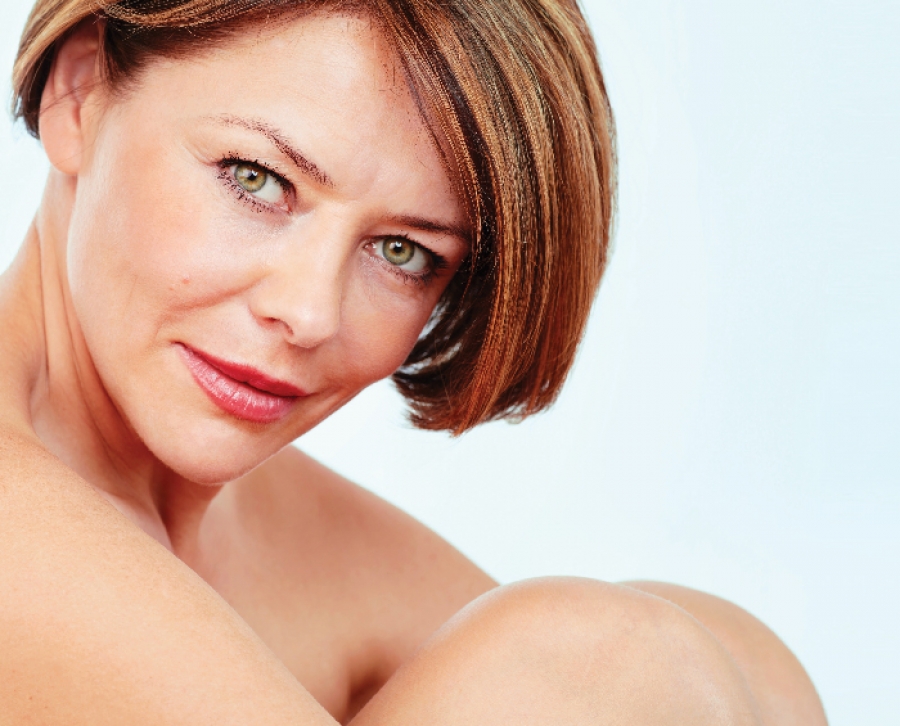Now more than ever, it is important to offer results-oriented skin care for mature skin and focus on all of the factors that contribute to the skin’s aging, including biological aging. Biological aging, also known as intrinsic aging, is the normal aging process that occurs genetically as people grow older. Unlike extrinsic aging, which is accumulative and can be fought with preventative measures, intrinsic aging is unavoidable. The symptoms of intrinsic aging tend to manifest in the 50s and 60s which, for women, links closely to going through menopause.
Menopause is the ending of a woman’s reproductive period and is physiologically defined by the lack of a menstrual cycle for at least 12 months. During the time prior to menopause and during menopause, there are various hormonal changes and declines occurring throughout the woman’s body. Hormones are chemical messengers that stimulate specific functions of organs, tissues, and cells in the body; they regulate growth, metabolism, reproduction, and a variety of other processes. Hormones affect both the internal body and the skin, which is the body’s largest organ. For women, the changes in estrogen levels and other hormones (like progesterone) that are brought on by menopause significantly impact the skin’s aging process. Menopause hastens the skin’s aging at the cellular level.
Due to these changes, menopausal skin requires expert care that addresses the aging process of the cells themselves, as well as how this manifests itself on the skin. In essence, all layers of the skin, including the cells, need to be addressed.
MENOPAUSE AND THE SKIN
Estrogen is produced by the ovaries, adrenal glands, and fat tissue. While it is often thought to be a female-specific hormone, both women and men produce estrogen. Estrogen is also the blanket term used to describe a group of chemically-similar hormones; therefore, estrogen is not a single hormone but a set of hormones. For example, estradiol (which is the most abundant during reproductive years), estriol (which is prevalent during pregnancy), and estrone (which is prevalent during menopause) are all considered estrogens.
Estrogen plays many crucial roles biologically besides reproduction. It is involved in bone formation, impacts capillary health and circulation, stimulates fat deposits, and is involved in protein synthesis (like collagen and elastin), the production of glycosaminoglycans, and helps regulate melanin and oil production. Plummeting estrogen levels will also impact the skin’s vascular network as capillaries harden (sclerose) and succumb to glycation. All in all, estrogen helps keep the body and skin youthful. Changing and declining levels of estrogen impact the skin’s capacity to function optimally and accelerates the aging process. Signs and symptoms of aging will be both superficial and deep as cellular function is impaired and all layers of the skin are affected.

A CLOSER LOOK AT CELLS
Humans are made up of a juxtaposition of billions of cells. The cell functions like a living being: it is born, it grows, it proliferates, and it dies. Life starts out as a single cell that is divided into two and then four and so on until adulthood. It breathes and nourishes itself with nutrients, allowing it to produce the energy that is crucial for it to function. Cellular energy, also known as adenosine triphosphate (ATP), keeps everything going. ATP is synthesized because it is needed and used almost immediately; there is a constant cycle of producing and consuming. As people age, ATP production diminishes, leading to cells that function more slowly because there is less energy.
Cells have many organelles, each with a different function. One of these organelles includes the nucleus, the home of the chromosomes. Chromosomes are composed of DNA molecules and proteins and are capped at the end with telomeres. These endcaps prevent chromosomes from weakening, unraveling, and fusing together. A telomere is often compared to the plastic end of a shoelace. Every time a cell divides, the telomeres become shorter; when the cell becomes too short, it either dies or retains genetic damage that can lead to mutations or cancer. Shortened telomeres have been associated with cardiovascular disease, cancer, and diabetes. Longer telomeres are linked to overall healthy living and longevity. As people age, the risk factors increase due to a weakened immune system and naturally-decreased cell division. Daily activities like sun exposure, oxidative stress, and glycation play a big role by damaging DNA within the cells.
Skin cells divide and grow in the basement membrane. From there, new cells are pushed up into the epidermis. Once they are in the epidermis, cells no longer receive nutrients. They start to begin the process of dying and shedding off to be replaced by more new cells.
Keratinocytes are most common among skin cells; they account for around 95 percent of the skin. The primary function of these cells is to create the barrier from the world. These cells are found in the basal layer of the stratified epithelium that comprises the epidermis. Keratinocytes are responsible for forming tight junctions with the nerves of the skin. The skin is the first line of defense and keratinocytes serve as a barrier between an organism and its environment. In addition, these cells prevent the loss of moisture, heat, and other important constituents of the body.
Cells are complex and have many different organelles and functions. In order to optimize the fight against aging, all aspects, not just some, of why cellular function decreases need to be addressed or professionals will yield subpar results.
ADDRESS AGING AT THE CELLULAR LEVEL
Increasing longevity, communication, defense potential, oxygenation, and energy within cells boosting cellular function will highly benefit menopausal skin and help combat intrinsic aging.
Longevity
All skin cells are constantly dividing and telomeres play a role in cell division. Studies show that people can act on a cell’s life span by protecting the genetic material of the cell, the telomeres and chromosomes. Baicalin protects telomeres and lipoamino acids boost protein synthesis that protects the cells. Together, these ingredients increase cellular longevity.
Communication
Cells receive and give information within themselves and their environment. Their life depends on receiving and processing information from the outside environment, including access to nutrients, variations in light levels, and/or temperature changes. Cells can also communicate between each other to synchronize and work like a team. With age, the cell membranes become damaged, causing a dysfunction in cellular communication. As a result, the body does not respond well and the skin repairs itself less efficiently. Lipoamino acids restore clear communication between cells.
Defense Potential
The skin is exposed to imbalances coming from hormonal changes, like menopause, oxidative stress from free radicals, and sun exposure. These factors lead to aging skin. While Langerhans cells play a prominent role in protecting the skin, their numbers decrease over the years. Lipoamino acids protect Langerhans cells and reinforce the defense potential of the skin.
Oxygenation
A supply of oxygen is crucial for cells to produce the energy required for their metabolic needs. Oxygen is a powerful detoxifier; when there is a lack of oxygen in the cells, toxins begin to damage skin functions and deplete the body of energy. Garden nasturtium extract facilitates the transportation and diffusion of oxygen for healthy microcirculation.
 Energy
Energy
Cells, like humans, need energy to sustain growth, metabolism, and reproduction. The body’s energy currency, ATP, is produced from food molecules like proteins, carbohydrates, and fats in the mitochondrion. ATP diminishes with age and causes the body to function more slowly. As a result, the appearance of wrinkles, loss of firmness, and dullness of complexion is accelerated. D-ribose accelerates the production of ATP.
When skin cells have increased functionality, the skin is healthier and acts younger; healthy cells produce healthy skin. They also allow the actives in skin care products to be better utilized by the skin, maximizing their effectiveness.
TREAT CHANGES TO ALL LAYERS OF THE SKIN
As a result of menopause, the skin becomes more thin, rough, and loose; wrinkles are more visible and dark spots appear. Therefore, mature clients have a bevy of skin care concerns and require global care. In order to provide optimum results, all layers of the skin must be addressed so that cellular function can
be addressed.
Epidermis
In the epidermis, dryness is a result of a reduction in oil production while dehydration indicates increased transepidermal water loss. Impaired barrier function and repair implies that the skin is compromised and less able to defend itself. In this layer of the skin, roughness is indicative of prolonged cell turnover. Pigmentation or a lack of radiance means that there is less regulation of melanin production while dullness or poor coloring implies that microcirculation is impaired, As the result, dermoepidermal junction hardens.
Dermis
In the dermis, deep dehydration means that less hyaluronic acid is being produced. Elastin production has decreased when lines and wrinkles deepen and collagen production has decreased when a lack of firmness and contour is seen.
Increasing cellular functions and providing a potent and comprehensive solution to the epidermis, dermoepidermal junction, and dermis can slow down the natural bio-chemical processes that occur with hormonally-compromised skin.
 Katherine Tomasso has spent over 20 years in the skin care and wellness industry. She brings a unique and innovative perspective and enjoys being part of the ever-changing face of the spa industry. As National Director of Education for YON-KA® Paris, Tomasso’s responsibilities include the development and implementation of YON-KA’s national educational programs. Tomasso has had a number of articles published in notable cosmetic and related prestige publications and is a frequent writer, collaborator, and lecturer within the industry.
Katherine Tomasso has spent over 20 years in the skin care and wellness industry. She brings a unique and innovative perspective and enjoys being part of the ever-changing face of the spa industry. As National Director of Education for YON-KA® Paris, Tomasso’s responsibilities include the development and implementation of YON-KA’s national educational programs. Tomasso has had a number of articles published in notable cosmetic and related prestige publications and is a frequent writer, collaborator, and lecturer within the industry.
